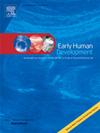Outcomes from an enhanced developmental screening programme in Singapore
IF 2.2
3区 医学
Q2 OBSTETRICS & GYNECOLOGY
引用次数: 0
Abstract
Introduction
Historically, low referral rates of 3–4 % have been reported from Singapore primary health care. Early identification of and intervention for developmental delays and autism enable achievement of optimal outcomes. An enhanced developmental screening (EDS) programme was introduced in primary care to improve identification of developmental delays and autism for children aged 18 and 30 months. This study evaluated prevalence of positive screening for developmental delays/autism at 18 months, identified associated socio-demographic risk factors and studied the correlation between primary care screening tools with outcomes following tertiary care assessments.
Methods
In primary care, EDS was conducted using Parents' Evaluation of Developmental Status (PEDS), Parents' Evaluation of Developmental Status: Developmental Milestones (PEDS:DM), Ages & Stages Questionnaires-Third Edition (ASQ-3) and Modified Checklist for Autism in Toddlers, Revised - Follow-Up (M-CHATR/F) along with collection of socio-demographic data. Tertiary care assessment included Developmental Profile-3 (DP-3) screening and, a developmental paediatrician consultation.
Results
Of 4212 children screened at 18 months, 14 % screened positive for developmental delays and 2 % for autism at primary care. Lower maternal education, ethnic minority status and lower socioeconomic status were associated with a positive screen. Moderate- strong correlation was seen between the ASQ-3 gross motor domain and DP-3 physical domain, moderate correlation between the communication domains of the 2 tools and the ASQ-3 personal-social domain with DP-3 adaptive domain.
Conclusion
EDS enabled improved identification of children for developmental delays/autism. Identification of socio-demographic risk factors will enable children from such families to be identified early and referred for intervention.
新加坡加强发育筛查项目的结果
从历史上看,新加坡初级卫生保健机构的转诊率为3 - 4%。发育迟缓和自闭症的早期识别和干预可以实现最佳结果。在初级保健中引入了一项增强的发育筛查(EDS)计划,以改善对18个月和30个月儿童的发育迟缓和自闭症的识别。本研究评估了18个月时发育迟缓/自闭症阳性筛查的患病率,确定了相关的社会人口危险因素,并研究了初级保健筛查工具与三级保健评估后结果之间的相关性。方法在初级保健阶段,采用父母发育状态评价量表(PEDS)、父母发育状态评价量表:发育里程碑量表(PEDS:DM)、年龄量表、年龄量表和量表;阶段问卷-第三版(ASQ-3)和修订的幼儿自闭症检查表,修订-随访(M-CHATR/F)以及收集的社会人口统计数据。三级保健评估包括发育概况-3 (DP-3)筛查和发育儿科医生咨询。结果在4212名18个月大的儿童中,14%的儿童在初级保健中筛查出发育迟缓阳性,2%的儿童筛查出自闭症。较低的母亲教育程度、少数民族地位和较低的社会经济地位与筛查呈阳性相关。ASQ-3粗大运动领域与DP-3物理领域存在中-强相关,两种工具的交流领域与个人-社会领域与DP-3自适应领域存在中-强相关。结论eds能够提高对发育迟缓/自闭症儿童的识别。确定社会人口风险因素将使这些家庭的儿童能够及早得到确认并接受干预。
本文章由计算机程序翻译,如有差异,请以英文原文为准。
求助全文
约1分钟内获得全文
求助全文
来源期刊

Early human development
医学-妇产科学
CiteScore
4.40
自引率
4.00%
发文量
100
审稿时长
46 days
期刊介绍:
Established as an authoritative, highly cited voice on early human development, Early Human Development provides a unique opportunity for researchers and clinicians to bridge the communication gap between disciplines. Creating a forum for the productive exchange of ideas concerning early human growth and development, the journal publishes original research and clinical papers with particular emphasis on the continuum between fetal life and the perinatal period; aspects of postnatal growth influenced by early events; and the safeguarding of the quality of human survival.
The first comprehensive and interdisciplinary journal in this area of growing importance, Early Human Development offers pertinent contributions to the following subject areas:
Fetology; perinatology; pediatrics; growth and development; obstetrics; reproduction and fertility; epidemiology; behavioural sciences; nutrition and metabolism; teratology; neurology; brain biology; developmental psychology and screening.
 求助内容:
求助内容: 应助结果提醒方式:
应助结果提醒方式:


